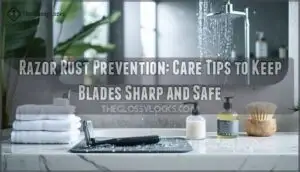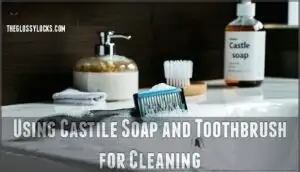This site is supported by our readers. We may earn a commission, at no cost to you, if you purchase through links.

Studies show that over half of people who use dull or rusty razors experience irritation, and some face more serious risks like folliculitis or even tetanus from contaminated cuts.
The good news? Preventing rust isn’t complicated. With a few simple daily habits and smart storage choices, you can keep your blades sharp, safe, and performing like new—saving your skin and your wallet in the process.
Table Of Contents
Key Takeaways
- Rust forms when moisture clings to razor blades after shaving, creating bacteria-harboring pits that cause skin infections like folliculitis in over 50% of users who skip proper blade care.
- Three simple habits prevent rust completely: rinse blades thoroughly with hot water after every shave, shake and pat them completely dry, and store them in open-air spots away from shower steam.
- Replace blades every 5-7 shaves or when you notice tugging, increased irritation, or visible rust—dull blades force you to press harder, creating micro-cuts that invite bacterial infections.
- Investing in quality stainless steel or titanium razors combined with vinegar-and-baking-soda deep cleans extends blade life by 20-50%, cutting waste and saving money while protecting your skin.
Why Razors Rust and How It Affects You
You’ve probably noticed that orange-brown tint creeping onto your razor—that’s rust, and it happens faster than you’d think. Understanding why blades corrode and what that means for your skin helps you make smarter choices about your shaving routine.
Let’s break down what’s really happening when your razor starts to rust and why it matters more than you might realize.
Causes of Razor Rust—Moisture, Humidity, and Oxidation
Your razor’s worst enemy isn’t time—it’s the water droplets clinging to the blade after every shave. When moisture lingers on metal, the oxidation process kicks in fast, turning that sharp edge into a rusty razor.
High humidity environments—like your shower—accelerate metal corrosion by keeping blades constantly damp. Once rust formation starts, it spreads quickly, compromising both dampness prevention efforts and corrosion prevention strategies you might try later.
How Rust Impacts Shaving Performance and Skin Health
Once rust takes hold, razor sharpness drops by up to 50%, forcing you to press harder and drag the blade across your skin. That friction triggers skin irritation in nearly half of shavers—itching, burning, and redness become routine.
But there’s more to worry about than discomfort:
- Microscopic rust pits harbor bacteria, turning your rusty razor into a breeding ground
- Bacterial growth explodes in humid storage, especially on uncleaned blades
- Micro-cuts from uneven edges invite infections like folliculitis and painful boils
- Healing slows down when contaminated blades introduce microbes into wounds
Your shaving safety depends on consistent razor maintenance and rust prevention—because a dull, corroded blade doesn’t just perform poorly, it jeopardizes your skin health. Understanding rust on skin is essential for maintaining hygiene and preventing infections.
Risks of Using Rusty or Dull Razors
Beyond poor performance, dull and rusty razors create real health hazards. Bacteria trapped in rust pits cause skin infection risks like folliculitis—painful red bumps that sometimes require antibiotics. While rust doesn’t directly cause tetanus, contaminated blades can introduce Clostridium tetani through cuts.
Worn edges increase razor burn causes and ingrown hair prevention failures, with studies showing irritation in over 50% of users post-shave.
Proper razor care and rust prevention methods are your best shaving safety tips for infection control and bacteria prevention. Understanding tetanus infection risks is essential for maintaining personal hygiene and safety.
Essential Daily Razor Care Habits
Taking care of your razor doesn’t need to be complicated, but a few simple habits make all the difference. The right routine keeps your blades sharp, your skin safe, and your wallet happy.
Here’s what you need to do after every shave.
Proper Cleaning Techniques After Each Use
Think of cleaning as hitting pause on the corrosion clock—every second spent under running water is a second saved from rust’s relentless creep.
Right after shaving, flip your razor blade upside down and blast it with hot water to flush trapped hairs and soap residue. Then grab an old toothbrush—dip it in castile soap if you’re dealing with stubborn buildup—and gently scrub between the blades where gunk hides.
Drying Razors to Prevent Moisture Buildup
Once that final rinse is done, shake off the excess water like you mean it—then pat the blade completely dry with a clean towel or let it air-dry in a spot with good airflow. Moisture control is your best defense against a rusty razor.
Here’s why drying matters for blade preservation:
- Stops oxidation before it starts—water + metal = rust
- Prevents bacterial buildup between shaves
- Extends blade sharpness and lifespan
- Reduces skin irritation from corrosion
- Essential razor maintenance and care habit
Even seconds of lingering dampness kick-start corrosion prevention’s worst enemy.
Smart Storage Solutions for Dryness
After you’ve dried your blade, where you stash it matters just as much as how you clean it. Keep your razor in a dry cabinet or use blade holders that promote airflow—never leave it pooling in the shower.
Razor cases and air tight containers work for travel, but daily moisture control means open-air storage away from steam. Smart dry storage tips equal serious rust prevention and razor life extension.
How Often to Replace Razor Blades
Even with perfect storage, your blade won’t last forever—most razors need fresh blades every 5 to 7 shaves to keep your skin happy and irritation-free.
Watch for these signs it’s time for blade replacement:
- Tugging or pulling during your shave
- Increased razor burn or irritation
- More passes needed for smoothness
- Visible nicks on the blade edge
- Rust spots appearing despite razor care
Fresh blades mean better shave frequency results and healthier skin.
Deep Cleaning and Rust Removal Methods
Sometimes daily care isn’t enough—rust can sneak in even with your best efforts. When it does, you need more than a quick rinse to restore your razor to working condition.
Here’s how to tackle stubborn buildup and bring your blade back to life.
Using Castile Soap and Toothbrush for Cleaning

A gentle scrub with castile soap and an old toothbrush is one of the simplest ways to keep your razor blades clean and rust-free between shaves. Just apply a drop of castile soap directly to the blade, then use gentle circular motions with the toothbrush to work between the cartridge crevices where gunk hides.
This sanitizing method removes soap scum, dead skin cells, and bacteria without damaging your razor—and it costs next to nothing.
Vinegar and Baking Soda Soak for Rust Removal
If rust has already crept in, white vinegar and baking soda work together like a chemistry experiment that actually pays off—the fizzy reaction loosens oxidation and lifts stubborn buildup right off the blade.
Here’s your rust removal game plan:
- Fill a small bowl with equal parts white vinegar and warm water
- Drop in your rusty razor and let it soak for 10-15 minutes
- Sprinkle baking soda directly onto the blade for extra fizz
- Scrub gently with a toothbrush to remove loosened rust
This natural cleaning solution handles even stubborn corrosion without harsh chemicals.
Rinsing and Drying for Lasting Results
Once you’ve scrubbed away the rust, thorough rinsing is what actually locks in your cleaning efforts—leftover vinegar or soap residue can trap new moisture and restart the corrosion cycle all over again.
Here’s your post-cleaning protocol for preventing rust and corrosion:
| Step | Razor Maintenance Tips |
|---|---|
| Rinse | Flush under hot water for 30 seconds to remove all cleaning solution |
| Shake | Flick blade sharply to dislodge trapped water between cartridges |
| Dry | Pat with clean towel or air-dry completely before storage |
| Store | Keep in dry storage away from shower steam and water spots |
This simple blade sanitizing routine stops water spot prevention issues before they start—your razor care doesn’t end until that blade’s bone-dry.
Sustainable Razor Use for Longevity and Savings
Taking care of your razor isn’t just about preventing rust—it’s about making smarter choices that save you money and help the planet. When you extend the life of your blades and invest in quality tools, you’re cutting down on waste while keeping more cash in your pocket.
Here’s how to make your razor routine more sustainable and budget-friendly.
Extending Razor Lifespan to Reduce Waste
Taking care of your razors isn’t just about saving money—it’s about shrinking your environmental footprint. Proper razor maintenance can extend blade lifespan by 20-50%, which means fewer blades hit the landfill.
Consider this: Americans toss about 2 billion disposable razors yearly. By mastering rust prevention and blade sharpening basics, you’re directly cutting waste while practicing sustainable shaving habits that benefit both your wallet and the planet.
Americans discard 2 billion razors annually—mastering rust prevention and blade care slashes waste while protecting your wallet and the planet
Budget-Friendly Razor Maintenance Tips
You don’t need expensive products or elaborate routines to keep your razors in top shape—just a few simple tricks that cost pennies. These DIY cleaning solutions and rust prevention methods deliver professional results without draining your wallet:
- White vinegar soaks remove corrosion for under $3 per bottle
- Mineral oil works brilliantly as an affordable razor oil alternative
- Baking soda scrubs tackle stubborn rust using pantry staples
- Old toothbrushes reach tight spaces during blade care sessions
- Proper drying costs nothing but prevents expensive replacements
Smart blade sharpening and razor care and storage habits beat pricey commercial products every time.
Choosing Durable Razors Like Merkur Long Handle
While smart maintenance matters, investing in a quality safety razor from the start saves you headaches down the road. Stainless steel models with ergonomic grip and thoughtful grip design—like the Merkur Long Handle—resist corrosion naturally and deliver consistent blade sharpness.
Their advanced safety features and razor material construction mean less frequent blade replacement, protecting both your skin and budget. Proper razor care and storage extends blade longevity even further.
Eco-Conscious Shaving Habits for Health and Environment
Making sustainable choices protects your skin and reduces environmental impact. Over 2 billion plastic razors end up in U.S. landfills annually—switching to reusable safety razors with natural ingredients and zero-waste shaving practices cuts that number drastically.
Sustainable shaving habits worth adopting:
- Choose eco-friendly products with green packaging to minimize plastic waste
- Use natural shaving creams instead of aerosol foams with harsh chemicals
- Switch to refillable safety razors for razor blade longevity and corrosion prevention
- Store blades properly—dry storage extends lifespan and promotes sustainable living
- Recycle metal blades through specialized programs promoting zero waste and sustainability
Eco-friendly shaving saves money while protecting waterways from parabens and sulfates.
Frequently Asked Questions (FAQs)
Can you use oil to prevent razor rust?
Oils like camellia, mineral oil, or Ballistol create a protective barrier that blocks moisture and oxygen—the two culprits behind corrosion.
This blade lubrication maintains sharpness while offering enhanced rust protection compared to leaving blades bare.
Do stainless steel razors ever rust completely?
Stainless steel razors resist corrosion better than regular steel, but they’re not invincible.
Over time, mechanical damage—like nicks or scratches—can compromise the protective chromium layer, allowing rust to take hold and spread through deeper metal layers.
Whats the best razor material for preventing rust?
In terms of playing it safe, titanium alloy takes the crown.
Stainless steel with copper plating or metal coatings offers excellent rust-resistant properties, while corrosion prevention methods like Zerust vapor shield protect razor blades from oxidation effectively.
Can rusty razors transfer tetanus to your skin?
Tetanus risk from rusty razors exists, but it’s commonly misunderstood. The bacteria lives in soil and feces, not rust itself.
However, corrosion creates rough surfaces where bacteria can hide, increasing skin infection risk and bacterial transfer during shaving.
Should you disinfect razors before rust removal?
Think of disinfectant as a safety net before rust removal begins. Sanitizing your razor blade with rubbing alcohol or hydrogen peroxide kills bacteria lurking beneath corrosion, protecting your skin during the cleaning process.
Conclusion
Rust doesn’t give warnings—it just shows up, uninvited, compromising your blade and your skin in one silent sweep. But now you’ve got the playbook: rinse thoroughly, dry completely, store smartly, and replace when performance dips. Razor rust prevention isn’t about flawlessness; it’s about consistency.
A few seconds of care after each shave protects you from irritation, infection, and wasted money. Your morning routine deserves better than dull, corroded blades. Treat your razor right, and it’ll return the favor—sharp, safe, and ready every single time.
- https://www.bloomberg.com/news/articles/2014-04-22/science-reveals-the-secret-to-making-your-razor-last
- https://www.chicagotribune.com/business/success/chi-ym-spending-1104nov04-story.html
- https://athenaclub.com/blogs/news/how-to-properly-store-your-razor-to-prevent-bacteria-and-rust
- https://www.asharperrazor.com/problem-razors-the-rusted-razor
- https://www.youtube.com/watch?v=ZGAtVZJknZs







